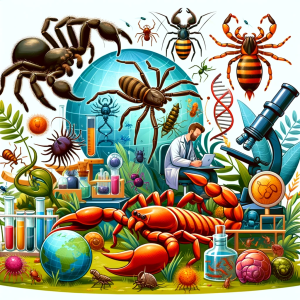
Discovering Spider Venom: A Peek into Nature’s Chemistry
Imagine a world where even the smallest creatures wield the power to immobilize prey and defend against threats with a single bite. This power lies in venom—a complex cocktail of bioactive molecules that nature has perfected over millions of years. Venomous animals, including snakes, scorpions, and spiders, use this potent secretion to hunt and protect themselves. But how exactly does this fascinating system develop, and what can we learn from it? A recent study goes into the mysterious world of spider venom, uncovering how these tiny predators develop their venom apparatus.
Unveiling the Mystery: Spider Venom Development
Venom is a crucial tool for survival in spiders. The common house spider, Parasteatoda tepidariorum, serves as an excellent model for understanding how these venom systems develop. Spiders’ venom apparatus consists of a pair of secretory glands connected to the fangs by ducts running through their chelicerae (or jaws). Researchers used advanced techniques like RNA sequencing and in situ hybridization to explore how these venom glands form and function from embryonic stages to adulthood.
From Embryo to Predator: The Journey of Venom Glands
The study revealed that the venom gland primordium, or the early stage of the gland, appears during the embryonic stage. This development begins at the tip of the chelicerae and moves towards the base by the end of the embryonic period. Post-hatching, the glands continue to grow into the spider’s prosoma (the front part of the body). By the time the spider is ready to leave the cocoon, the venom apparatus is nearly complete, ready to produce the potent toxins that make spiders such effective hunters.
The Role of Genes: A Peek into the Genetic Blueprint
Researchers identified several genes that play crucial roles in the development and function of the venom glands. Some genes were specific to the secretory cells that produce venom, while others were associated with the muscle layer surrounding the glands. For instance, genes like sum-1, sage, and forkhead showed distinct patterns of expression, indicating their specialized roles in venom gland development. Understanding these genetic markers provides valuable insights into the evolutionary origins and specialization of venom systems in spiders.
The Evolutionary Puzzle: Venom Glands’ Origins
One intriguing aspect of the study is its contribution to the debate about the evolutionary origins of venom glands. There are two main hypotheses: venom glands evolved from either salivary glands or silk glands. The study’s findings suggest a closer link to salivary glands based on the expression patterns of certain genes. This discovery adds a new piece to the puzzle, helping scientists trace the evolutionary history of these complex and efficient biological systems.
Practical Implications: Beyond Basic Research
While this research primarily advances our understanding of spider biology, it also has practical implications. Venoms are a treasure trove of bioactive molecules with potential applications in medicine and pharmacology. By unraveling the genetic and developmental mechanisms behind venom production, scientists can explore new avenues for drug development, potentially leading to innovative treatments for various medical conditions.
Conclusion: Nature’s Masterpiece
The study of spider venom glands offers a fascinating glimpse into nature’s ingenuity. From the intricate development of venom apparatus in tiny spider embryos to the genetic blueprints that drive these processes, we gain a deeper appreciation for the complexity and elegance of biological systems. As researchers continue to explore these mysteries, who knows what other secrets nature holds, waiting to be discovered and harnessed for the benefit of all?
Engage with Us!
We’d love to hear your thoughts on this captivating topic. Consider these questions:
- How do you think understanding venom development in spiders could influence medical research?
- What other natural phenomena do you find fascinating and worth exploring?
Leave your comments below and join the discussion!
Explore and Learn with Science:
Dive into groundbreaking research and inspiring stories with ‘This Week in Science’! Perfect for teachers and science enthusiasts, our free weekly newsletter expands your horizons in teaching and learning. Join us today and reshape your engagement with science.



